Clinical Case Study: Effective Pain Management Post-Laparoscopic
VerifiedAdded on 2023/06/11
|10
|2150
|233
Case Study
AI Summary
This clinical case study focuses on the pain management of a patient, Darren, following an elective laparoscopic surgery. The study identifies the patient's potential pain due to surgical incisions, evidenced by grimacing and a pain score >3/10. Nursing interventions include pharmacological approaches using medications like Paracetamol and Tramadol, non-pharmacological methods such as comfort therapy and massage, and psychological interventions like cognitive behavioral therapy and acceptance and commitment therapy. The interventions align with Australian Nursing and Midwifery Board standards, emphasizing a person-centered care approach. The study reflects on the learning process, highlighting the importance of addressing physical, mental, and emotional aspects equally for effective patient care. Desklib provides access to similar case studies and study resources for students.

Clinical Case Study
Paraphrase This Document
Need a fresh take? Get an instant paraphrase of this document with our AI Paraphraser
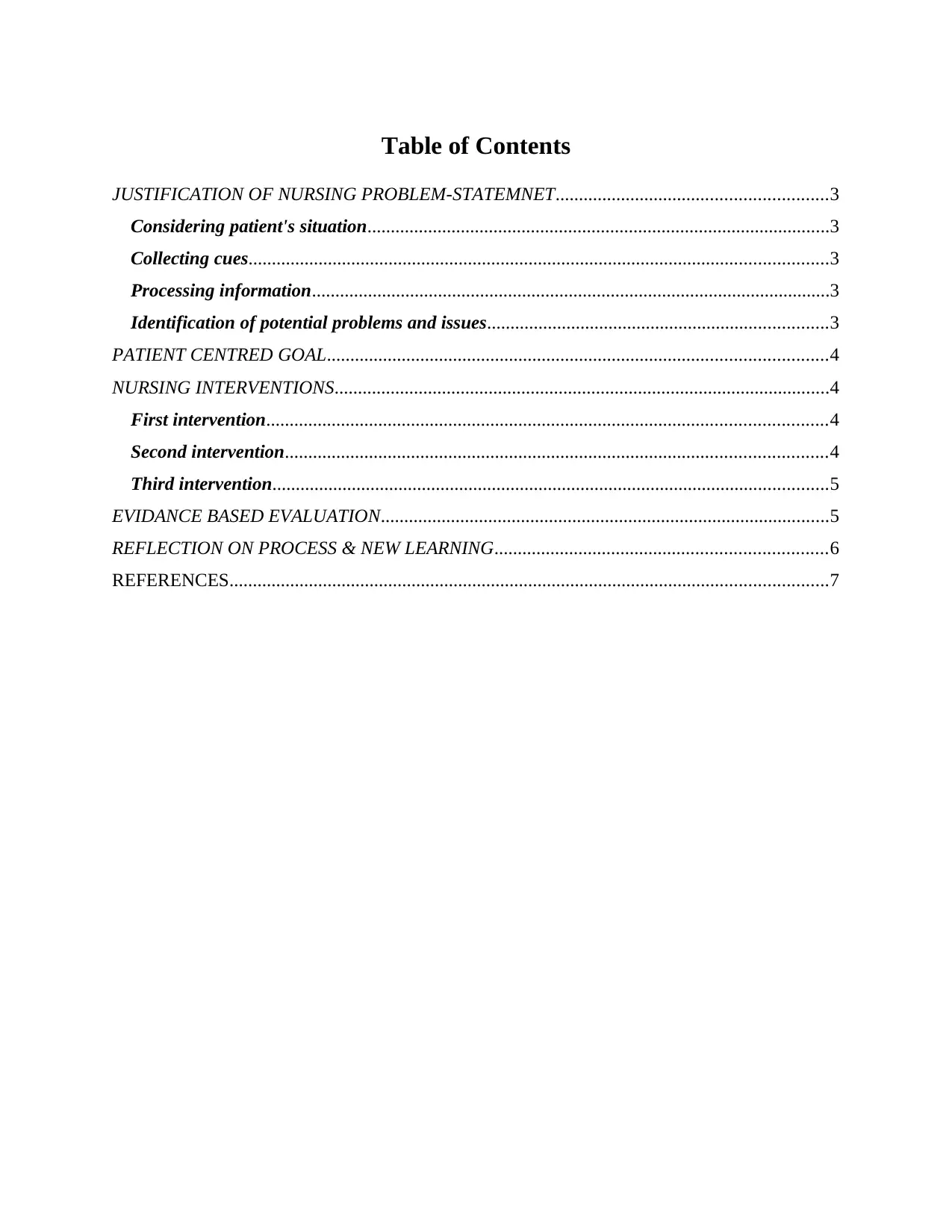
Table of Contents
JUSTIFICATION OF NURSING PROBLEM-STATEMNET..........................................................3
Considering patient's situation...................................................................................................3
Collecting cues............................................................................................................................3
Processing information...............................................................................................................3
Identification of potential problems and issues.........................................................................3
PATIENT CENTRED GOAL...........................................................................................................4
NURSING INTERVENTIONS..........................................................................................................4
First intervention........................................................................................................................4
Second intervention....................................................................................................................4
Third intervention.......................................................................................................................5
EVIDANCE BASED EVALUATION................................................................................................5
REFLECTION ON PROCESS & NEW LEARNING.......................................................................6
REFERENCES................................................................................................................................7
JUSTIFICATION OF NURSING PROBLEM-STATEMNET..........................................................3
Considering patient's situation...................................................................................................3
Collecting cues............................................................................................................................3
Processing information...............................................................................................................3
Identification of potential problems and issues.........................................................................3
PATIENT CENTRED GOAL...........................................................................................................4
NURSING INTERVENTIONS..........................................................................................................4
First intervention........................................................................................................................4
Second intervention....................................................................................................................4
Third intervention.......................................................................................................................5
EVIDANCE BASED EVALUATION................................................................................................5
REFLECTION ON PROCESS & NEW LEARNING.......................................................................6
REFERENCES................................................................................................................................7
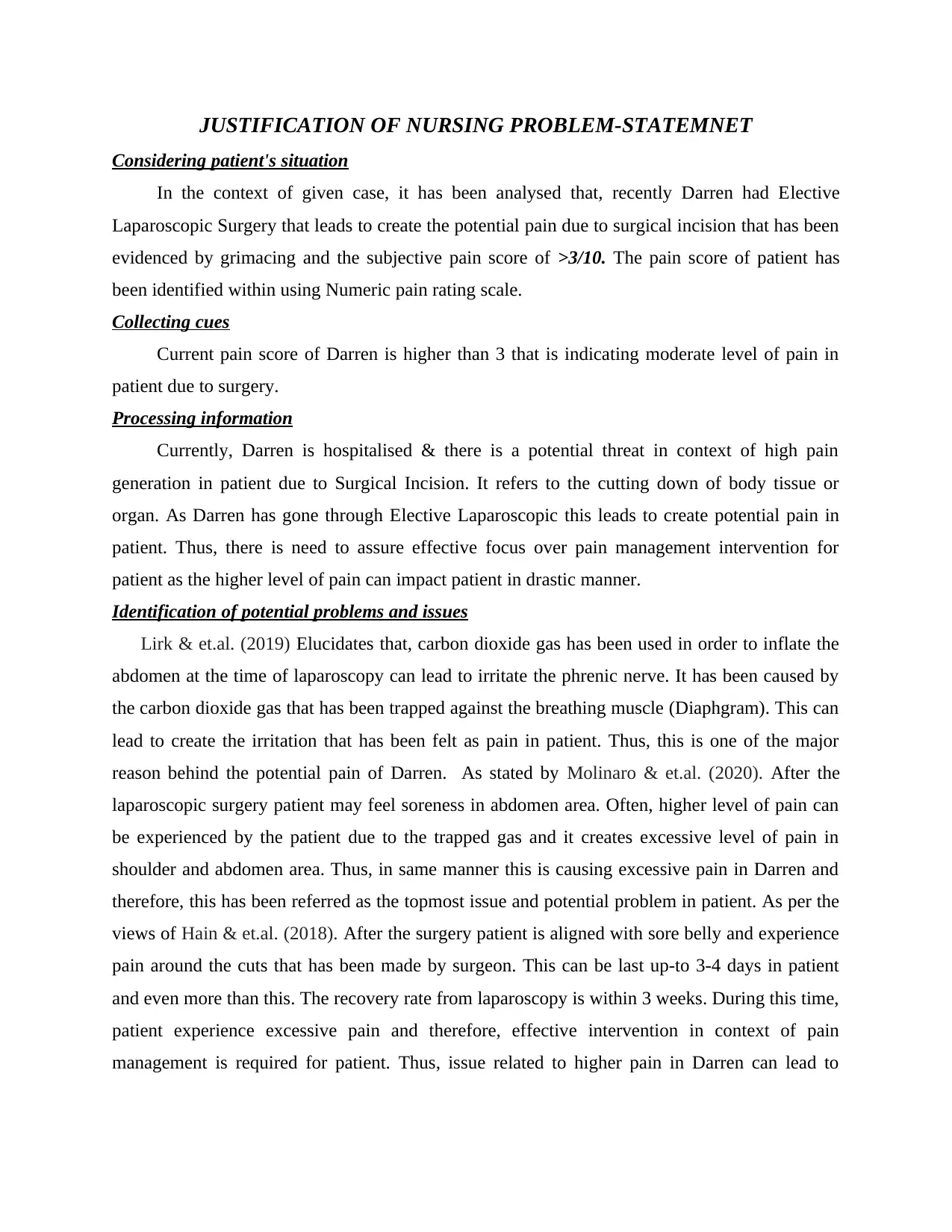
JUSTIFICATION OF NURSING PROBLEM-STATEMNET
Considering patient's situation
In the context of given case, it has been analysed that, recently Darren had Elective
Laparoscopic Surgery that leads to create the potential pain due to surgical incision that has been
evidenced by grimacing and the subjective pain score of >3/10. The pain score of patient has
been identified within using Numeric pain rating scale.
Collecting cues
Current pain score of Darren is higher than 3 that is indicating moderate level of pain in
patient due to surgery.
Processing information
Currently, Darren is hospitalised & there is a potential threat in context of high pain
generation in patient due to Surgical Incision. It refers to the cutting down of body tissue or
organ. As Darren has gone through Elective Laparoscopic this leads to create potential pain in
patient. Thus, there is need to assure effective focus over pain management intervention for
patient as the higher level of pain can impact patient in drastic manner.
Identification of potential problems and issues
Lirk & et.al. (2019) Elucidates that, carbon dioxide gas has been used in order to inflate the
abdomen at the time of laparoscopy can lead to irritate the phrenic nerve. It has been caused by
the carbon dioxide gas that has been trapped against the breathing muscle (Diaphgram). This can
lead to create the irritation that has been felt as pain in patient. Thus, this is one of the major
reason behind the potential pain of Darren. As stated by Molinaro & et.al. (2020). After the
laparoscopic surgery patient may feel soreness in abdomen area. Often, higher level of pain can
be experienced by the patient due to the trapped gas and it creates excessive level of pain in
shoulder and abdomen area. Thus, in same manner this is causing excessive pain in Darren and
therefore, this has been referred as the topmost issue and potential problem in patient. As per the
views of Hain & et.al. (2018). After the surgery patient is aligned with sore belly and experience
pain around the cuts that has been made by surgeon. This can be last up-to 3-4 days in patient
and even more than this. The recovery rate from laparoscopy is within 3 weeks. During this time,
patient experience excessive pain and therefore, effective intervention in context of pain
management is required for patient. Thus, issue related to higher pain in Darren can lead to
Considering patient's situation
In the context of given case, it has been analysed that, recently Darren had Elective
Laparoscopic Surgery that leads to create the potential pain due to surgical incision that has been
evidenced by grimacing and the subjective pain score of >3/10. The pain score of patient has
been identified within using Numeric pain rating scale.
Collecting cues
Current pain score of Darren is higher than 3 that is indicating moderate level of pain in
patient due to surgery.
Processing information
Currently, Darren is hospitalised & there is a potential threat in context of high pain
generation in patient due to Surgical Incision. It refers to the cutting down of body tissue or
organ. As Darren has gone through Elective Laparoscopic this leads to create potential pain in
patient. Thus, there is need to assure effective focus over pain management intervention for
patient as the higher level of pain can impact patient in drastic manner.
Identification of potential problems and issues
Lirk & et.al. (2019) Elucidates that, carbon dioxide gas has been used in order to inflate the
abdomen at the time of laparoscopy can lead to irritate the phrenic nerve. It has been caused by
the carbon dioxide gas that has been trapped against the breathing muscle (Diaphgram). This can
lead to create the irritation that has been felt as pain in patient. Thus, this is one of the major
reason behind the potential pain of Darren. As stated by Molinaro & et.al. (2020). After the
laparoscopic surgery patient may feel soreness in abdomen area. Often, higher level of pain can
be experienced by the patient due to the trapped gas and it creates excessive level of pain in
shoulder and abdomen area. Thus, in same manner this is causing excessive pain in Darren and
therefore, this has been referred as the topmost issue and potential problem in patient. As per the
views of Hain & et.al. (2018). After the surgery patient is aligned with sore belly and experience
pain around the cuts that has been made by surgeon. This can be last up-to 3-4 days in patient
and even more than this. The recovery rate from laparoscopy is within 3 weeks. During this time,
patient experience excessive pain and therefore, effective intervention in context of pain
management is required for patient. Thus, issue related to higher pain in Darren can lead to
⊘ This is a preview!⊘
Do you want full access?
Subscribe today to unlock all pages.

Trusted by 1+ million students worldwide
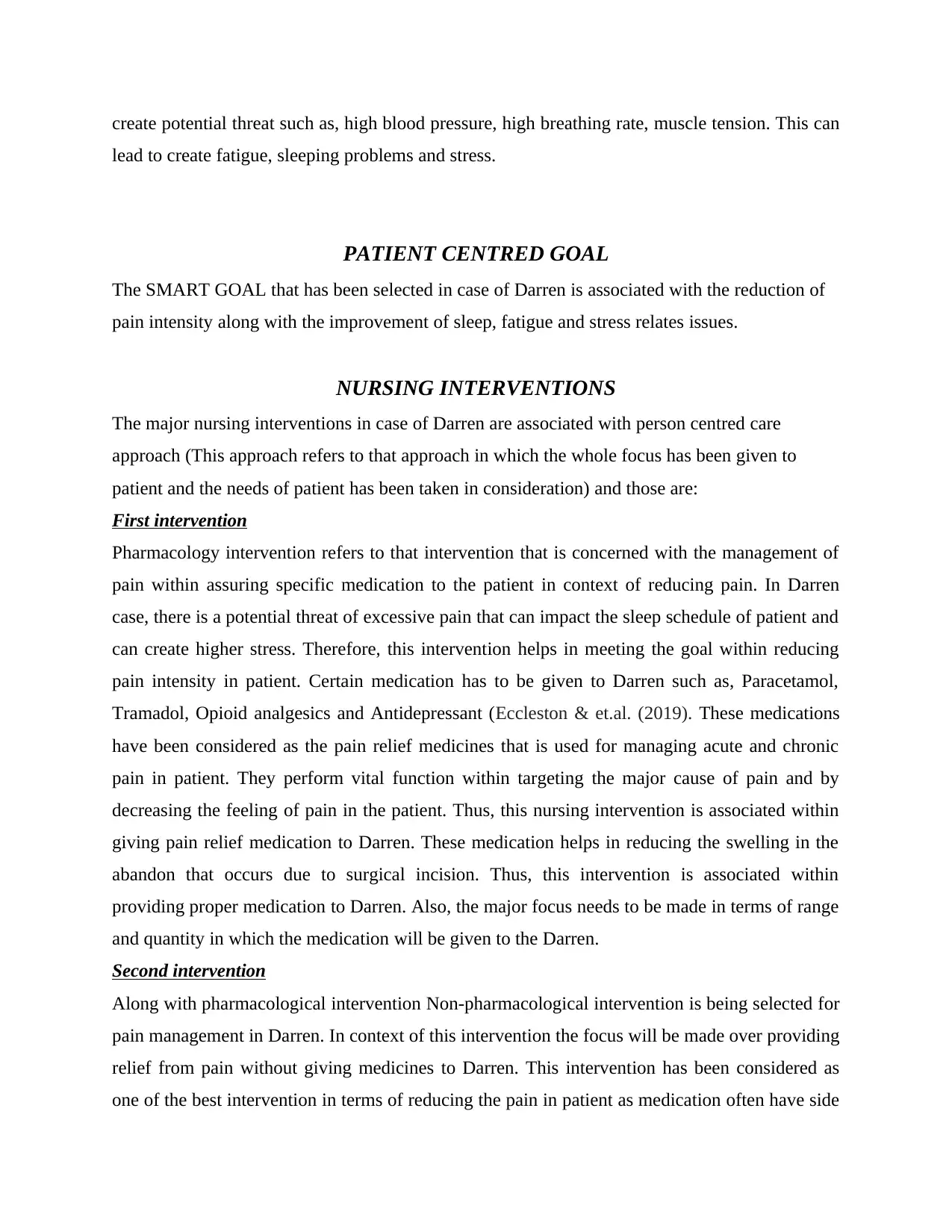
create potential threat such as, high blood pressure, high breathing rate, muscle tension. This can
lead to create fatigue, sleeping problems and stress.
PATIENT CENTRED GOAL
The SMART GOAL that has been selected in case of Darren is associated with the reduction of
pain intensity along with the improvement of sleep, fatigue and stress relates issues.
NURSING INTERVENTIONS
The major nursing interventions in case of Darren are associated with person centred care
approach (This approach refers to that approach in which the whole focus has been given to
patient and the needs of patient has been taken in consideration) and those are:
First intervention
Pharmacology intervention refers to that intervention that is concerned with the management of
pain within assuring specific medication to the patient in context of reducing pain. In Darren
case, there is a potential threat of excessive pain that can impact the sleep schedule of patient and
can create higher stress. Therefore, this intervention helps in meeting the goal within reducing
pain intensity in patient. Certain medication has to be given to Darren such as, Paracetamol,
Tramadol, Opioid analgesics and Antidepressant (Eccleston & et.al. (2019). These medications
have been considered as the pain relief medicines that is used for managing acute and chronic
pain in patient. They perform vital function within targeting the major cause of pain and by
decreasing the feeling of pain in the patient. Thus, this nursing intervention is associated within
giving pain relief medication to Darren. These medication helps in reducing the swelling in the
abandon that occurs due to surgical incision. Thus, this intervention is associated within
providing proper medication to Darren. Also, the major focus needs to be made in terms of range
and quantity in which the medication will be given to the Darren.
Second intervention
Along with pharmacological intervention Non-pharmacological intervention is being selected for
pain management in Darren. In context of this intervention the focus will be made over providing
relief from pain without giving medicines to Darren. This intervention has been considered as
one of the best intervention in terms of reducing the pain in patient as medication often have side
lead to create fatigue, sleeping problems and stress.
PATIENT CENTRED GOAL
The SMART GOAL that has been selected in case of Darren is associated with the reduction of
pain intensity along with the improvement of sleep, fatigue and stress relates issues.
NURSING INTERVENTIONS
The major nursing interventions in case of Darren are associated with person centred care
approach (This approach refers to that approach in which the whole focus has been given to
patient and the needs of patient has been taken in consideration) and those are:
First intervention
Pharmacology intervention refers to that intervention that is concerned with the management of
pain within assuring specific medication to the patient in context of reducing pain. In Darren
case, there is a potential threat of excessive pain that can impact the sleep schedule of patient and
can create higher stress. Therefore, this intervention helps in meeting the goal within reducing
pain intensity in patient. Certain medication has to be given to Darren such as, Paracetamol,
Tramadol, Opioid analgesics and Antidepressant (Eccleston & et.al. (2019). These medications
have been considered as the pain relief medicines that is used for managing acute and chronic
pain in patient. They perform vital function within targeting the major cause of pain and by
decreasing the feeling of pain in the patient. Thus, this nursing intervention is associated within
giving pain relief medication to Darren. These medication helps in reducing the swelling in the
abandon that occurs due to surgical incision. Thus, this intervention is associated within
providing proper medication to Darren. Also, the major focus needs to be made in terms of range
and quantity in which the medication will be given to the Darren.
Second intervention
Along with pharmacological intervention Non-pharmacological intervention is being selected for
pain management in Darren. In context of this intervention the focus will be made over providing
relief from pain without giving medicines to Darren. This intervention has been considered as
one of the best intervention in terms of reducing the pain in patient as medication often have side
Paraphrase This Document
Need a fresh take? Get an instant paraphrase of this document with our AI Paraphraser
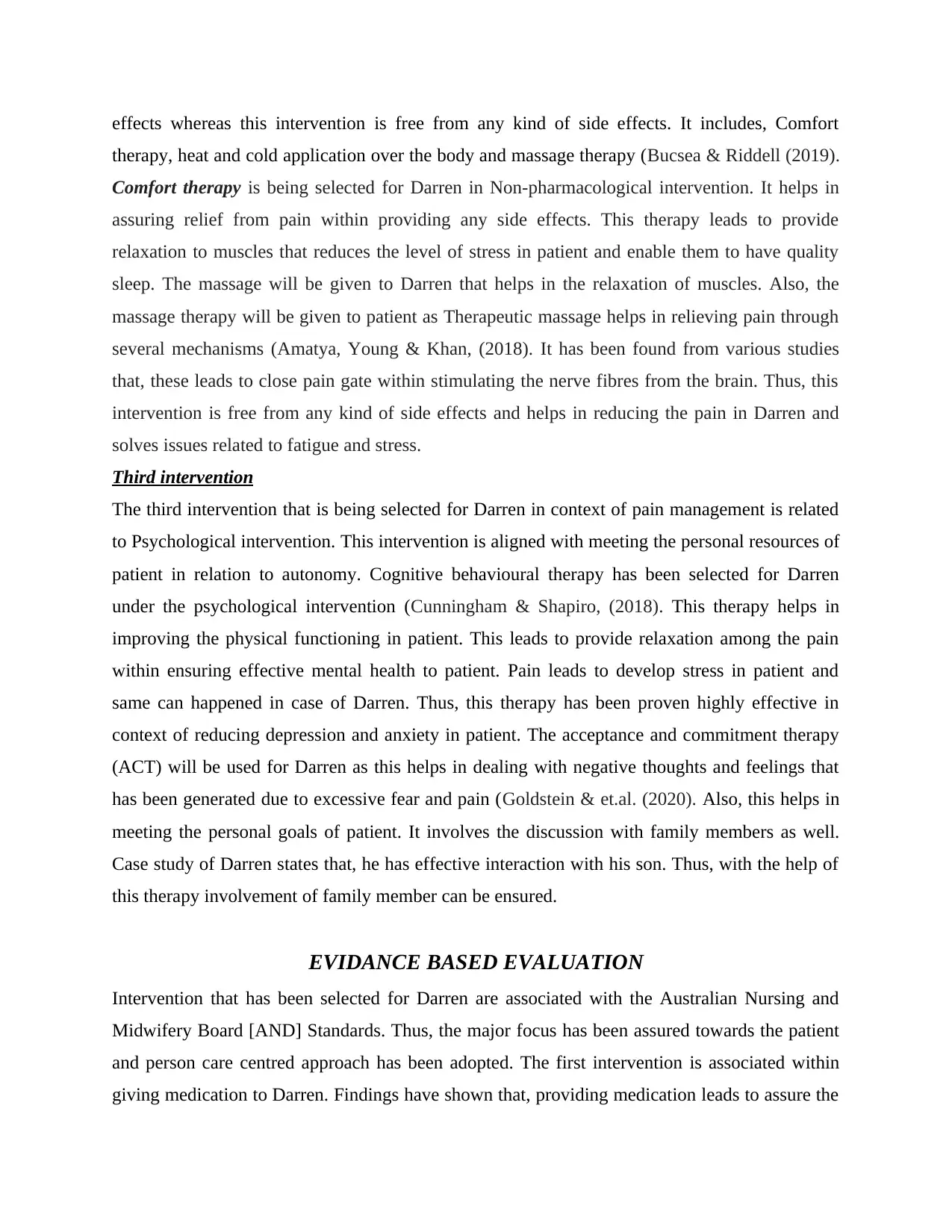
effects whereas this intervention is free from any kind of side effects. It includes, Comfort
therapy, heat and cold application over the body and massage therapy (Bucsea & Riddell (2019).
Comfort therapy is being selected for Darren in Non-pharmacological intervention. It helps in
assuring relief from pain within providing any side effects. This therapy leads to provide
relaxation to muscles that reduces the level of stress in patient and enable them to have quality
sleep. The massage will be given to Darren that helps in the relaxation of muscles. Also, the
massage therapy will be given to patient as Therapeutic massage helps in relieving pain through
several mechanisms (Amatya, Young & Khan, (2018). It has been found from various studies
that, these leads to close pain gate within stimulating the nerve fibres from the brain. Thus, this
intervention is free from any kind of side effects and helps in reducing the pain in Darren and
solves issues related to fatigue and stress.
Third intervention
The third intervention that is being selected for Darren in context of pain management is related
to Psychological intervention. This intervention is aligned with meeting the personal resources of
patient in relation to autonomy. Cognitive behavioural therapy has been selected for Darren
under the psychological intervention (Cunningham & Shapiro, (2018). This therapy helps in
improving the physical functioning in patient. This leads to provide relaxation among the pain
within ensuring effective mental health to patient. Pain leads to develop stress in patient and
same can happened in case of Darren. Thus, this therapy has been proven highly effective in
context of reducing depression and anxiety in patient. The acceptance and commitment therapy
(ACT) will be used for Darren as this helps in dealing with negative thoughts and feelings that
has been generated due to excessive fear and pain (Goldstein & et.al. (2020). Also, this helps in
meeting the personal goals of patient. It involves the discussion with family members as well.
Case study of Darren states that, he has effective interaction with his son. Thus, with the help of
this therapy involvement of family member can be ensured.
EVIDANCE BASED EVALUATION
Intervention that has been selected for Darren are associated with the Australian Nursing and
Midwifery Board [AND] Standards. Thus, the major focus has been assured towards the patient
and person care centred approach has been adopted. The first intervention is associated within
giving medication to Darren. Findings have shown that, providing medication leads to assure the
therapy, heat and cold application over the body and massage therapy (Bucsea & Riddell (2019).
Comfort therapy is being selected for Darren in Non-pharmacological intervention. It helps in
assuring relief from pain within providing any side effects. This therapy leads to provide
relaxation to muscles that reduces the level of stress in patient and enable them to have quality
sleep. The massage will be given to Darren that helps in the relaxation of muscles. Also, the
massage therapy will be given to patient as Therapeutic massage helps in relieving pain through
several mechanisms (Amatya, Young & Khan, (2018). It has been found from various studies
that, these leads to close pain gate within stimulating the nerve fibres from the brain. Thus, this
intervention is free from any kind of side effects and helps in reducing the pain in Darren and
solves issues related to fatigue and stress.
Third intervention
The third intervention that is being selected for Darren in context of pain management is related
to Psychological intervention. This intervention is aligned with meeting the personal resources of
patient in relation to autonomy. Cognitive behavioural therapy has been selected for Darren
under the psychological intervention (Cunningham & Shapiro, (2018). This therapy helps in
improving the physical functioning in patient. This leads to provide relaxation among the pain
within ensuring effective mental health to patient. Pain leads to develop stress in patient and
same can happened in case of Darren. Thus, this therapy has been proven highly effective in
context of reducing depression and anxiety in patient. The acceptance and commitment therapy
(ACT) will be used for Darren as this helps in dealing with negative thoughts and feelings that
has been generated due to excessive fear and pain (Goldstein & et.al. (2020). Also, this helps in
meeting the personal goals of patient. It involves the discussion with family members as well.
Case study of Darren states that, he has effective interaction with his son. Thus, with the help of
this therapy involvement of family member can be ensured.
EVIDANCE BASED EVALUATION
Intervention that has been selected for Darren are associated with the Australian Nursing and
Midwifery Board [AND] Standards. Thus, the major focus has been assured towards the patient
and person care centred approach has been adopted. The first intervention is associated within
giving medication to Darren. Findings have shown that, providing medication leads to assure the
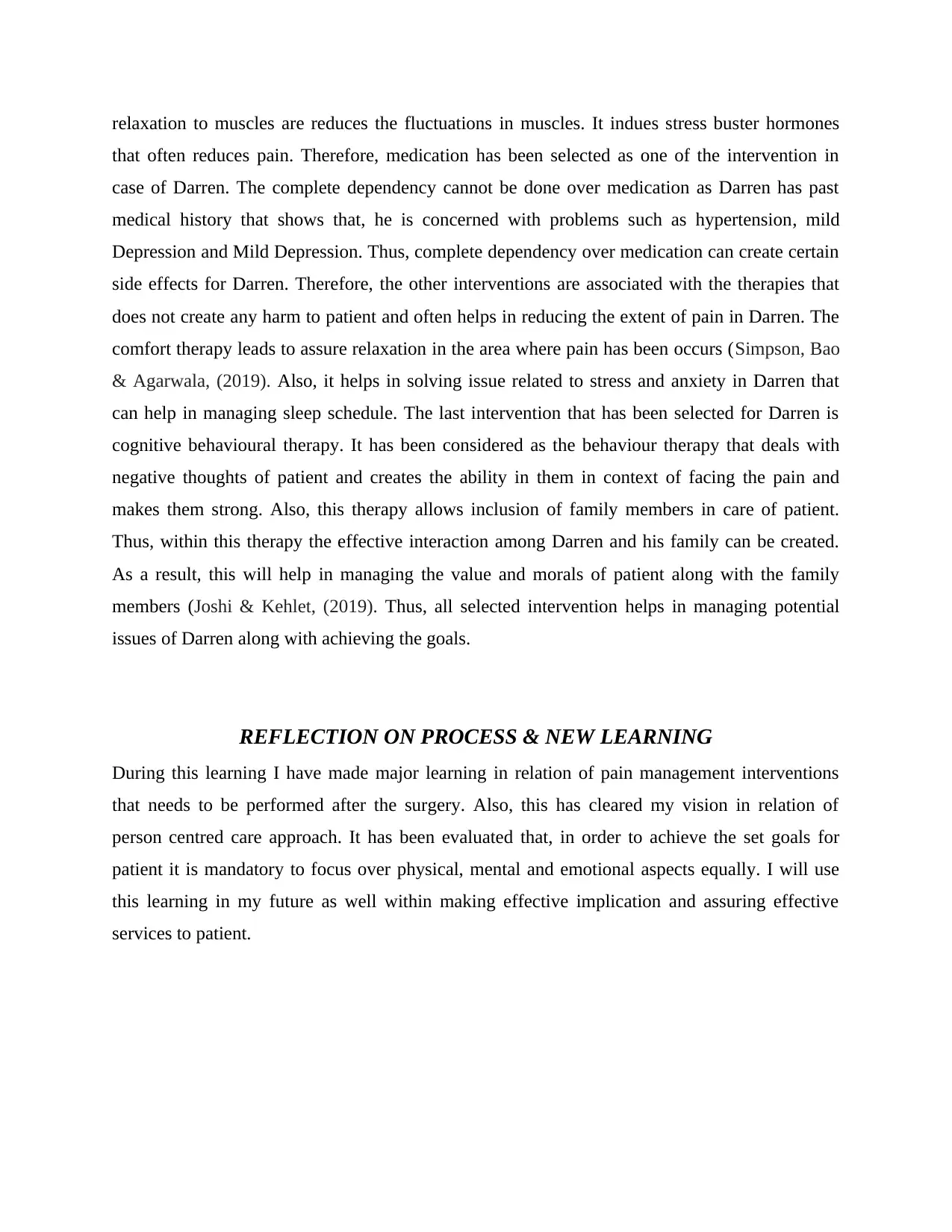
relaxation to muscles are reduces the fluctuations in muscles. It indues stress buster hormones
that often reduces pain. Therefore, medication has been selected as one of the intervention in
case of Darren. The complete dependency cannot be done over medication as Darren has past
medical history that shows that, he is concerned with problems such as hypertension, mild
Depression and Mild Depression. Thus, complete dependency over medication can create certain
side effects for Darren. Therefore, the other interventions are associated with the therapies that
does not create any harm to patient and often helps in reducing the extent of pain in Darren. The
comfort therapy leads to assure relaxation in the area where pain has been occurs (Simpson, Bao
& Agarwala, (2019). Also, it helps in solving issue related to stress and anxiety in Darren that
can help in managing sleep schedule. The last intervention that has been selected for Darren is
cognitive behavioural therapy. It has been considered as the behaviour therapy that deals with
negative thoughts of patient and creates the ability in them in context of facing the pain and
makes them strong. Also, this therapy allows inclusion of family members in care of patient.
Thus, within this therapy the effective interaction among Darren and his family can be created.
As a result, this will help in managing the value and morals of patient along with the family
members (Joshi & Kehlet, (2019). Thus, all selected intervention helps in managing potential
issues of Darren along with achieving the goals.
REFLECTION ON PROCESS & NEW LEARNING
During this learning I have made major learning in relation of pain management interventions
that needs to be performed after the surgery. Also, this has cleared my vision in relation of
person centred care approach. It has been evaluated that, in order to achieve the set goals for
patient it is mandatory to focus over physical, mental and emotional aspects equally. I will use
this learning in my future as well within making effective implication and assuring effective
services to patient.
that often reduces pain. Therefore, medication has been selected as one of the intervention in
case of Darren. The complete dependency cannot be done over medication as Darren has past
medical history that shows that, he is concerned with problems such as hypertension, mild
Depression and Mild Depression. Thus, complete dependency over medication can create certain
side effects for Darren. Therefore, the other interventions are associated with the therapies that
does not create any harm to patient and often helps in reducing the extent of pain in Darren. The
comfort therapy leads to assure relaxation in the area where pain has been occurs (Simpson, Bao
& Agarwala, (2019). Also, it helps in solving issue related to stress and anxiety in Darren that
can help in managing sleep schedule. The last intervention that has been selected for Darren is
cognitive behavioural therapy. It has been considered as the behaviour therapy that deals with
negative thoughts of patient and creates the ability in them in context of facing the pain and
makes them strong. Also, this therapy allows inclusion of family members in care of patient.
Thus, within this therapy the effective interaction among Darren and his family can be created.
As a result, this will help in managing the value and morals of patient along with the family
members (Joshi & Kehlet, (2019). Thus, all selected intervention helps in managing potential
issues of Darren along with achieving the goals.
REFLECTION ON PROCESS & NEW LEARNING
During this learning I have made major learning in relation of pain management interventions
that needs to be performed after the surgery. Also, this has cleared my vision in relation of
person centred care approach. It has been evaluated that, in order to achieve the set goals for
patient it is mandatory to focus over physical, mental and emotional aspects equally. I will use
this learning in my future as well within making effective implication and assuring effective
services to patient.
⊘ This is a preview!⊘
Do you want full access?
Subscribe today to unlock all pages.

Trusted by 1+ million students worldwide
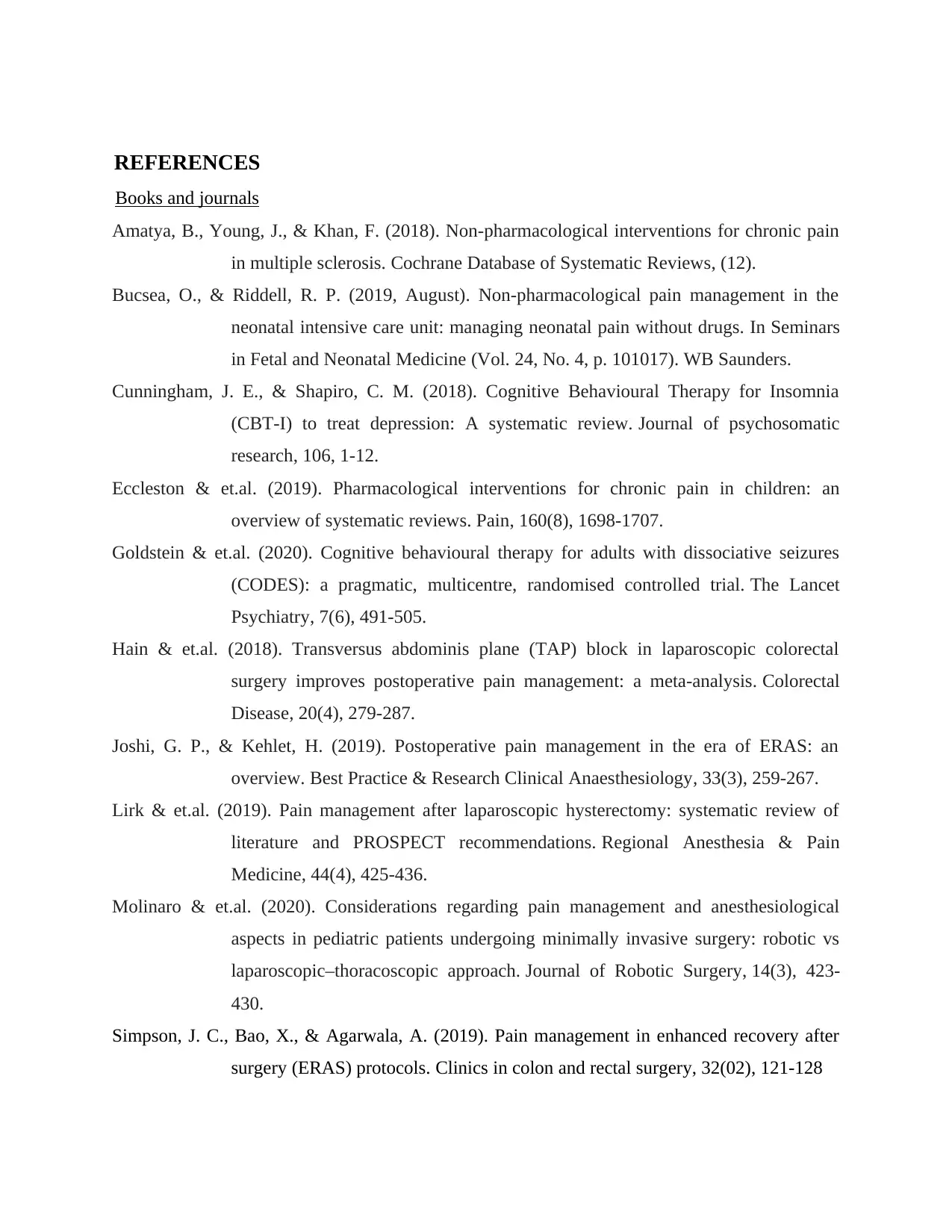
REFERENCES
Books and journals
Amatya, B., Young, J., & Khan, F. (2018). Non‐pharmacological interventions for chronic pain
in multiple sclerosis. Cochrane Database of Systematic Reviews, (12).
Bucsea, O., & Riddell, R. P. (2019, August). Non-pharmacological pain management in the
neonatal intensive care unit: managing neonatal pain without drugs. In Seminars
in Fetal and Neonatal Medicine (Vol. 24, No. 4, p. 101017). WB Saunders.
Cunningham, J. E., & Shapiro, C. M. (2018). Cognitive Behavioural Therapy for Insomnia
(CBT-I) to treat depression: A systematic review. Journal of psychosomatic
research, 106, 1-12.
Eccleston & et.al. (2019). Pharmacological interventions for chronic pain in children: an
overview of systematic reviews. Pain, 160(8), 1698-1707.
Goldstein & et.al. (2020). Cognitive behavioural therapy for adults with dissociative seizures
(CODES): a pragmatic, multicentre, randomised controlled trial. The Lancet
Psychiatry, 7(6), 491-505.
Hain & et.al. (2018). Transversus abdominis plane (TAP) block in laparoscopic colorectal
surgery improves postoperative pain management: a meta‐analysis. Colorectal
Disease, 20(4), 279-287.
Joshi, G. P., & Kehlet, H. (2019). Postoperative pain management in the era of ERAS: an
overview. Best Practice & Research Clinical Anaesthesiology, 33(3), 259-267.
Lirk & et.al. (2019). Pain management after laparoscopic hysterectomy: systematic review of
literature and PROSPECT recommendations. Regional Anesthesia & Pain
Medicine, 44(4), 425-436.
Molinaro & et.al. (2020). Considerations regarding pain management and anesthesiological
aspects in pediatric patients undergoing minimally invasive surgery: robotic vs
laparoscopic–thoracoscopic approach. Journal of Robotic Surgery, 14(3), 423-
430.
Simpson, J. C., Bao, X., & Agarwala, A. (2019). Pain management in enhanced recovery after
surgery (ERAS) protocols. Clinics in colon and rectal surgery, 32(02), 121-128
Books and journals
Amatya, B., Young, J., & Khan, F. (2018). Non‐pharmacological interventions for chronic pain
in multiple sclerosis. Cochrane Database of Systematic Reviews, (12).
Bucsea, O., & Riddell, R. P. (2019, August). Non-pharmacological pain management in the
neonatal intensive care unit: managing neonatal pain without drugs. In Seminars
in Fetal and Neonatal Medicine (Vol. 24, No. 4, p. 101017). WB Saunders.
Cunningham, J. E., & Shapiro, C. M. (2018). Cognitive Behavioural Therapy for Insomnia
(CBT-I) to treat depression: A systematic review. Journal of psychosomatic
research, 106, 1-12.
Eccleston & et.al. (2019). Pharmacological interventions for chronic pain in children: an
overview of systematic reviews. Pain, 160(8), 1698-1707.
Goldstein & et.al. (2020). Cognitive behavioural therapy for adults with dissociative seizures
(CODES): a pragmatic, multicentre, randomised controlled trial. The Lancet
Psychiatry, 7(6), 491-505.
Hain & et.al. (2018). Transversus abdominis plane (TAP) block in laparoscopic colorectal
surgery improves postoperative pain management: a meta‐analysis. Colorectal
Disease, 20(4), 279-287.
Joshi, G. P., & Kehlet, H. (2019). Postoperative pain management in the era of ERAS: an
overview. Best Practice & Research Clinical Anaesthesiology, 33(3), 259-267.
Lirk & et.al. (2019). Pain management after laparoscopic hysterectomy: systematic review of
literature and PROSPECT recommendations. Regional Anesthesia & Pain
Medicine, 44(4), 425-436.
Molinaro & et.al. (2020). Considerations regarding pain management and anesthesiological
aspects in pediatric patients undergoing minimally invasive surgery: robotic vs
laparoscopic–thoracoscopic approach. Journal of Robotic Surgery, 14(3), 423-
430.
Simpson, J. C., Bao, X., & Agarwala, A. (2019). Pain management in enhanced recovery after
surgery (ERAS) protocols. Clinics in colon and rectal surgery, 32(02), 121-128
Paraphrase This Document
Need a fresh take? Get an instant paraphrase of this document with our AI Paraphraser


.
⊘ This is a preview!⊘
Do you want full access?
Subscribe today to unlock all pages.

Trusted by 1+ million students worldwide

2
1 out of 10
Related Documents
Your All-in-One AI-Powered Toolkit for Academic Success.
+13062052269
info@desklib.com
Available 24*7 on WhatsApp / Email
![[object Object]](/_next/static/media/star-bottom.7253800d.svg)
Unlock your academic potential
Copyright © 2020–2025 A2Z Services. All Rights Reserved. Developed and managed by ZUCOL.



